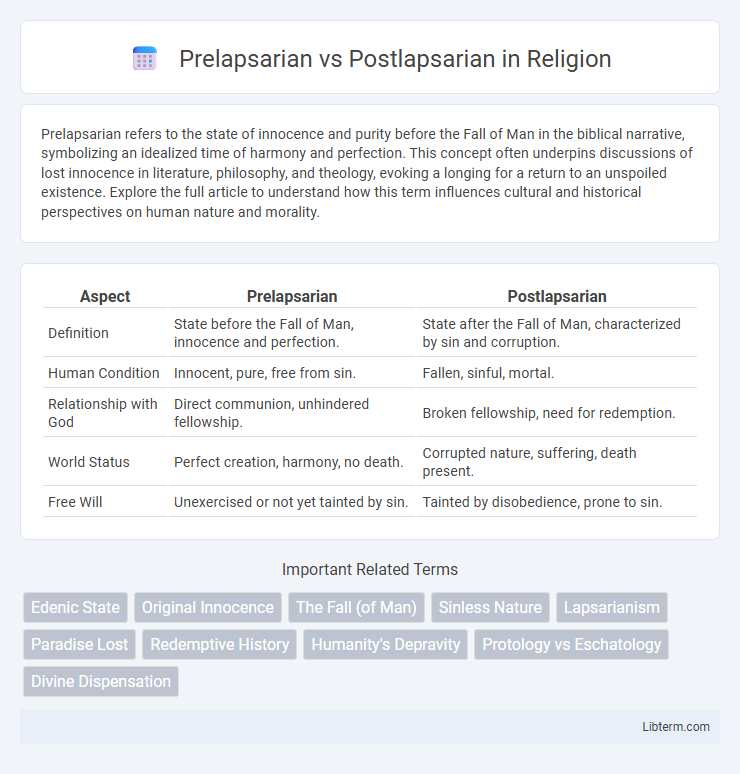Prelapsarian refers to the state of innocence and purity before the Fall of Man in the biblical narrative, symbolizing an idealized time of harmony and perfection. This concept often underpins discussions of lost innocence in literature, philosophy, and theology, evoking a longing for a return to an unspoiled existence. Explore the full article to understand how this term influences cultural and historical perspectives on human nature and morality.
Table of Comparison
| Aspect | Prelapsarian | Postlapsarian |
|---|---|---|
| Definition | State before the Fall of Man, innocence and perfection. | State after the Fall of Man, characterized by sin and corruption. |
| Human Condition | Innocent, pure, free from sin. | Fallen, sinful, mortal. |
| Relationship with God | Direct communion, unhindered fellowship. | Broken fellowship, need for redemption. |
| World Status | Perfect creation, harmony, no death. | Corrupted nature, suffering, death present. |
| Free Will | Unexercised or not yet tainted by sin. | Tainted by disobedience, prone to sin. |
Defining Prelapsarian and Postlapsarian
Prelapsarian refers to the state of humanity or existence before the Fall of Man, characterized by innocence, harmony, and perfection as described in biblical theology and literature. Postlapsarian denotes the condition following the Fall, marked by sin, suffering, and moral corruption, reflecting the altered human nature and world. These terms are foundational in theological discussions on original sin, human nature, and redemption.
Historical Origins of the Terms
The terms Prelapsarian and Postlapsarian originate from theological discourse describing the state of humanity before and after the Fall of Man in the Christian tradition, specifically referencing the biblical account in Genesis. Prelapsarian denotes the innocence and purity in the Garden of Eden before Adam and Eve's transgression, while Postlapsarian refers to the fallen, sinful condition of humanity subsequently. These concepts were extensively developed by early Church Fathers and medieval theologians to explore moral and existential implications rooted in Christian doctrine.
Theological Perspectives on the Fall
Prelapsarian theology explores the state of humanity and creation before the Fall of Adam and Eve, emphasizing innocence, original righteousness, and perfect communion with God. Postlapsarian perspectives focus on the consequences of the Fall, including original sin, human depravity, and the necessity of divine grace for redemption. Theological discussions often analyze how these doctrines influence doctrines of salvation, free will, and the nature of evil within Christian thought.
Prelapsarian: The State of Innocence
Prelapsarian refers to the state of innocence and purity before the Fall of Man, characterized by harmony with God, nature, and oneself. This era is often depicted as a paradise where moral knowledge was innate, and humans existed without sin or suffering. The concept emphasizes unblemished existence and divine favor, contrasting sharply with the corrupted, post-fall human condition marked by knowledge of good and evil and moral struggle.
Postlapsarian: Life After the Fall
Postlapsarian refers to the period and condition of humanity after the Fall of Adam and Eve, characterized by sin, moral struggle, and a fallen nature. This concept highlights a world marked by suffering, death, and the loss of original innocence, influencing theological doctrines on human nature and redemption. Postlapsarian perspectives emphasize the need for grace and salvation in the aftermath of the primordial transgression.
Impact on Literature and Art
Prelapsarian themes often symbolize innocence, purity, and an idealized state of existence, profoundly influencing Romantic literature and Renaissance art by inspiring depictions of unspoiled nature and perfect harmony. Postlapsarian concepts embody human fallibility and suffering, shaping works across various genres that explore themes of sin, redemption, and moral complexity, such as John Milton's *Paradise Lost* and Dario Argento's *Suspiria*. The contrast between these states drives rich symbolism and narrative tension, making the Prelapsarian and Postlapsarian dichotomy a central motif in theological and cultural expressions in literature and visual arts.
Prelapsarian vs Postlapsarian in Philosophy
Prelapsarian philosophy explores the state of human nature and existence before the Fall in the Garden of Eden, emphasizing innocence, purity, and harmony with the divine. Postlapsarian thought addresses the condition after the Fall, highlighting human imperfection, moral struggle, and the consequences of original sin on free will and knowledge. This dichotomy profoundly influences theological discussions on ethics, human nature, and the possibility of redemption.
Symbolism and Metaphors of the Fall
Prelapsarian symbolizes an ideal state of innocence, purity, and harmony with nature, often represented by the Garden of Eden, where humanity lives in untainted communion with the divine. Postlapsarian reflects the symbolic consequences of the Fall, marked by loss, exile, and moral corruption, embodying the transition from innocence to experience, and the human condition of suffering and redemption. Metaphors such as the forbidden fruit and the serpent convey temptation and disobedience, illustrating the profound spiritual and existential rupture between the prelapsarian perfection and postlapsarian fallen existence.
Modern Interpretations and Debates
Modern interpretations of prelapsarian and postlapsarian concepts often explore human nature, morality, and innocence through theological and philosophical lenses. Debates center on whether prelapsarian humanity embodied perfect innocence or a state of potential, while postlapsarian views emphasize the consequences of the Fall, including sin and moral complexity. Contemporary scholars analyze these paradigms to understand their implications for ethics, free will, and redemption in modern religious and secular contexts.
Implications for Contemporary Thought
The distinctions between Prelapsarian and Postlapsarian states highlight fundamental shifts in human nature, morality, and knowledge that influence contemporary ethical frameworks and theological interpretations. Prelapsarian concepts emphasize innocence and untested virtue, while Postlapsarian views acknowledge human fallibility and the necessity of grace or redemption, shaping modern debates on free will and moral responsibility. These paradigms inform contemporary discourse in philosophy, psychology, and religious studies by framing human existence in relation to idealized origins and consequential realities.
Prelapsarian Infographic

 libterm.com
libterm.com